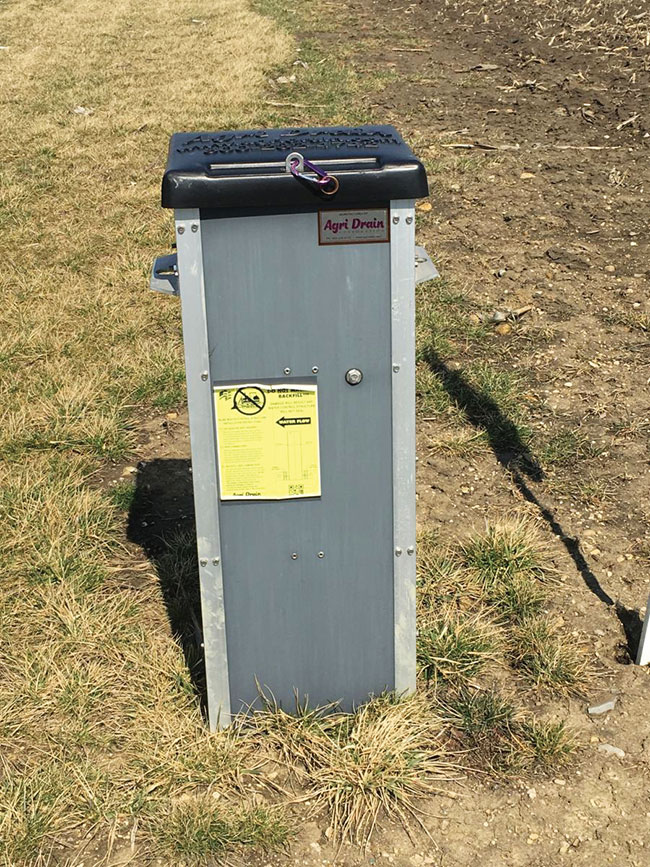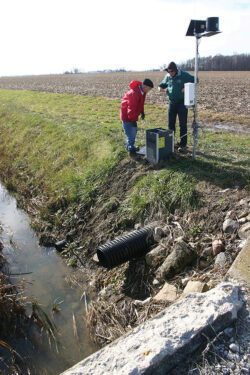
Features
Drainage Management Systems
When times are unpredictable
Lessons learned from drainage water management in Ohio
March 11, 2024 By Jack Kazmierski
 A field-installed drainage water management structure.
Image courtesy of Ohio State University Extension
A field-installed drainage water management structure.
Image courtesy of Ohio State University Extension Historically, drainage has been part of a wider issue for farmers in Ohio. According to Vinayak Shedekar, research scientist, Department of Food, Agricultural and Biological Engineering at Ohio State University, “For more than 200 years, we have known that you can’t grow crops in the area without draining the soil.”
Historically, this was marshland, Shedekar explains. “Or, if it wasn’t marshland, the regions we now call ‘the corn belt,’ had poorly-drained soil,” he adds.
If we go all the way back in history to the days of the settlers, Shedekar says that when they tried to farm the land, their biggest challenge was how to sustain crop production, “and drainage came up as the practice that allowed them to be able to grow the crops in the first place.”
Fast-forward to our century, and Shedekar says we now know that crop yield can double when a plot of land is properly drained. Experiments show that surface drainage, tile drainage or a combination of both can have a major impact on yield.
However, that’s only part of the problem. The other issue is the variability in the amount of rain Ohio might get in a given year. Some years might be very wet, while others might be very dry. “So in undrained lots,” explains Shedekar, “they actually had years where they did not have any yield.”
The plots of land that were properly drained, on the other hand, did not experience years where they had zero yield. “In their cases,” Shedekar adds, “the variability in yield was plus or minus 20 percent.”
The research that was conducted proved that proper drainage techniques not only boost yield, but they also take the risk out of the equation by providing a more uniform yield. “However,” Shedekar warns, “just because you have drainage, doesn’t mean the yield variability goes down to zero. That’s because other factors will play a part, which is why we still see a 20 percent yield variability.”
The practice of drainage water management, or controlled drainage, came into existence when that 20 percent variability was no longer seen as acceptable, although Shedekar notes that, “the primary benefit of controlled drainage is the reduction in nutrient losses from the field.”
Best management practices explained
When it comes to controlled drainage, Shedekar says there are many best management practices (BMPs). “You can divide them into categories,” he explains. “In-field, edge-of-field and stream level, or watershed level. In-field practices include cover crops, nutrient management, and conservation tillage. They’re not all water management related practices, but they are conservation practices.”
Drainage water management, Shedekar adds, is more of an edge-of-the-field practice, and he warns that there may be a bit of confusion about the terminology.
“Drainage water management and controlled drainage are used interchangeably,” he explain. “But drainage water management can also be a broader term for managing the drainage water. So you could take that water from the field, collect it in a reservoir, and recycle that water back into the system using overhead irrigation or a sub-irrigation type of a system.”
This is the approach Shedekar says has worked very well in Ohio. Collecting excess water in a reservoir during the wet months, and then using that same water to irrigate crops in the drier months simply makes sense. “We have already tested this drainage water recycling system, even adding a combination of wetland in there, and we found good results,” he says.
To take it one step further, drainage ditches can be employed as part of a drainage network, Shedekar says. “So if you’re managing water at the ditch levels, that still would be considered drainage water management,” he adds.
Edge-of-field BMPs are all about structural practices. The water is concentrated into a singular outlet at the edge of the field, whether that’s a tile outlet or a concentrated surface pathway, Shedekar explains. “Examples include controlled drainage, any kind of nutrient-removal structure, like a wood-chip bioreactor for nitrate or phosphorus removal. Saturated buffers are another example.”
In-stream BMPs are employed where you have hundreds or thousands of acres of land contributing to a drainage ditch or a stream, and you want to improve the water quality. Best practices would include a two-stage ditch channel design or a self-forming channel design, Shedekar says.
“There is a new practice that we’re experimenting with recently,” he adds. “It’s something called ‘cascading waterways.’ It’s a field-scale practice, and instead of creating just a regular grass waterway, if you have a good amount of relief, then think about a stepped approach where you’re creating artificial cascades of water. At every stage, you’re pooling some water behind a low-level dam, and it’s almost like creating a small wetland cell along that waterway, which would essentially slow down the water, and pool the water, which results in additional water quality benefits.”

Inspecting and adjusting boards to manage water table level.
Image courtesy of USDA-ARS Soil Drainage Unit
Promising results
Shedekar says that controlled drainage is one of the practices that was adopted in Ohio early on, “And I think Ohio may be one of the leading states for the adoption of controlled drainage, just in the last eight or 10 years.”
Results seem to be promising. “There are no official numbers per se,” he adds, “But based on my working relationship with the funding agencies, we know that there have been about 30 to 40,000 acres of farmland that have received controlled drainage as a practice, and I would say that a majority of that was done in the last five years.”
According to Shedekar, controlled drainage practices have resulted in a 41 percent reduction in annual discharge from tile outlets, a 40 percent lower nitrate load with a variable effect on phosphorus loss, a six percent boost to corn crop yields, and a 3.5 percent boost to soybean crop yields.
Planning for the future
While these are encouraging numbers, more research has to be done to prepare for an uncertain future. “If you look at 20 years from now, and 75 years from now, every corn-producing grower is going to say that they wish they had water for supplemental irrigation here in Ohio,” says Shedekar.
He adds that the irrigation challenges aren’t limited to Ohio. Rather, the entire midwest, and even the entire U.S. will have to deal with challenges in the future, due to ongoing soil degradation and changing weather patterns.
Climate change alone will have a major impact. “By 2030, Ohio is going to be more like the southern portions of Indiana and Illinois, and by the end of the century, we’re going to be more like Arkansas during the summer months, and more like North Carolina in the winter months,” he adds.
What this means, Shedekar explains, is that Ohio will see a very challenging water situation, coupled with very high summer temperatures.
“So if you’re a farmer, you’re going to be looking for a really good drainage system to get rid of flooding waters and excess rain,” he adds. “And in the summer, you’re going to be crying if you got rid of all that water, and now you have none.”
Even today, Ohio farmers struggle with water issues. “Very few farms in Northwest Ohio have irrigation, and the challenge is that we don’t have a source of water to rely on during the summertime,” Shedekar says.
History has shown us that marshland can be turned into productive farmland when best management practices are put in place.
Perhaps the lessons we have already learned from drainage water management best practices, as well as what we have yet to learn and implement, will prepare us for the climate-related challenges that are just over the horizon. DC
Print this page